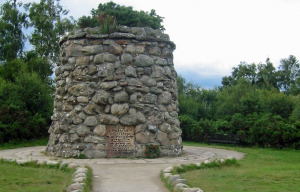In 1707, after centuries of intermittent conflict, Scotland and England agreed to a political union. Residents of the Scottish Highlands, many of them Roman Catholic, were not happy, considering themselves disadvantaged by the Protestant English kings. Catholic Charles Edward Stuart also opposed the English Protestants, who had deposed his grandfather, King James II of England, in 1688. In 1745, Charles formed a “Jacobite” army consisting largely of Catholic Highlanders to retake the crown for himself and the Catholics. After early victories in Scotland and England, Charles, known as “Bonnie Prince Charlie,” retreated to the Highlands to rebuild his army and await support from Catholic France. He was pursued by forces loyal to Protestant King George II, commanded by the Duke of Cumberland.
Over objections of his advisors, Charles engaged Cumberland in a moor near the Highland village of Culloden on April 16, 1746. In the last ever pitched battle on British soil, Cumberland’s forces annihilated the Jacobites in about an hour. Charles escaped, finding his way to France and then Rome, but Cumberland showed his followers no mercy. He pillaged Highland homes and farms, killed wounded soldiers, and executed Jacobite supporters, earning him the title of “Butcher.” Parliament banned Highlanders not in the military from wearing clan tartans.
A nineteenth century cairn erected on the Culloden Battlefield honors “the gallant Highlanders who fought for Scotland and Price Charlie.” Weathered stones mark mass graves where Highland soldiers were buried according to their clans. In 2007, 300 years after the merger of Scotland and England, the National Trust for Scotland added a visitors’ center to the battle site, featuring a 360 degree film that “relives the horror of the battle.”
For Scottish nationalists, the Culloden Battlefield is holy ground, creating emotions akin to those some Americans experience at Gettysburg. For everyone else, the battlefield provides another lesson, learned all too often, of the role religious differences have played in history’s battles.
